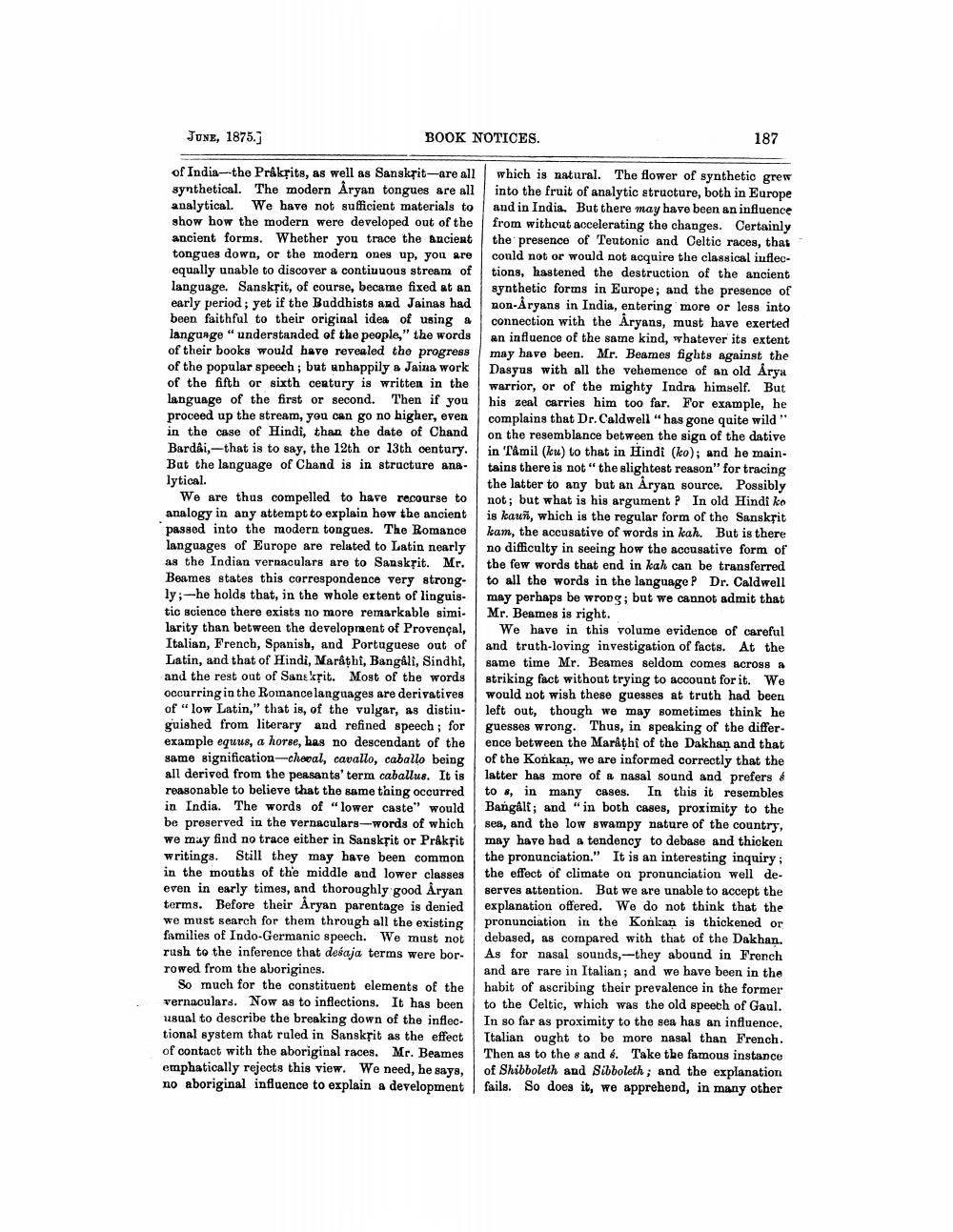________________
JUNE, 1875.j
BOOK NOTICES.
187
of India--the Prakrits, as well as Sanskrit-are all which is natural. The flower of synthetic grew synthetical. The modern Aryan tongues are all into the fruit of analytic structure, both in Europe analytical. We have not sufficient materials to and in India. But there may have been an influence show how the modern were developed out of the from without accelerating the changes. Certainly ancient forms. Whether you trace the ancient the presence of Teutonic and Celtic races, that tongues down, or the modern ones up, you are could not or would not acquire the classical inflecequally unable to discover a contiuuous stream of tions, hastened the destruction of the ancient language. Sanskrit, of course, became fixed at an synthetic forms in Europe; and the presence of early period; yet if the Buddhists and Jainas had
non-Aryans in India, entering more or less into been faithful to their original idea of using a connection with the Aryang, must have exerted langunge" understanded of the people," the words an influence of the same kind, whatever its extent of their books would have revealed the progress may have been. Mr. Beames fights against the of the popular speech; but anhappily a Jaina work Dasyus with all the vehemence of an old Arya of the fifth or sixth century is written in the
warrior, or of the mighty Indra himself. But language of the first or second. Then if you his zeal carries him too far. For example, he proceed up the stream, you can go no higher, even complains that Dr. Caldwell " has gone quite wild" in the case of Hindi, than the date of Chand
on the resemblance between the sign of the dative Bardai,- that is to say, the 12th or 13th century. 1 in Tamil (ku) to that in Hindi (leo); and he mainBut the language of Chand is in structure ana. tains there is not "the slightest reason" for tracing lytical.
the latter to any but an Aryan source. Possibly We are thus compelled to have recourse to not; but what is his argument ? In old Hindi ko analogy in any attempt to explain how the ancient
is kaun, which is the regular form of the Sanskrit passed into the modern tongues. The Romance kam, the accusative of words in kah. But is there languages of Europe are related to Latin nearly no difficulty in seeing how the accusative form of as the Indian vernaculars are to Sanskpit. Mr. the few words that end in kah can be transferred Beames states this correspondence very strong. to all the words in the language P Dr. Caldwell ly:-he holds that, in the whole extent of linguis- may perhaps be wrong; but we cannot admit that tic science there exists no more remarkable simi. Mr. Beames is right. larity than between the development of Provençal, We have in this volume evidence of careful Italian, French, Spanish, and Portuguese out of and truth-loving investigation of facts. At the Latin, and that of Hindi, Marathi, Bangali, Sindhi, same time Mr. Beames seldom comes across a and the rest out of Sans ksit. Most of the words striking fact without trying to account for it. We occurring in the Romance languages are derivatives would not wish these guesses at truth had been of " low Latin," that is, of the vulgar, as distin- left out, though we may sometimes think he guished from literary and refined speech; for guesses wrong. Thus, in speaking of the differexample equus, a horse, has no descendant of the lence between the Maraths of the Dakhan and that same signification--cheval, cavallo, caballo being of the Konkan, we are informed correctly that the all derived from the peasants' term caballus. It is latter has more of a nasal sound and prefers & reasonable to believe that the same thing occurred to in many cases. In this it resembles in India. The words of " lower caste" would Bangalt; and "in both cases, proximity to the be preserved in the vernaculars--words of which sea, and the low swampy nature of the country, we may find no trace either in Sansksit or Prákşit may have had a tendency to debase and thicken writings. Still they may have been common the pronunciation." It is an interesting inquiry: in the mouths of the middle and lower classes the effect of climate on pronunciation well deeven in early times, and thoroughly good Aryan serves attention. But we are unable to accept the terms. Before their Aryan parentage is denied explanation offered. We do not think that the we must search for them through all the existing pronunciation in the Konkan is thickened or families of Indo-Germanic speech. We must not debased, as compared with that of the Dakhan. rush te the inference that deśaja terms were bor. As for nasal sounds,-they abound in French rowed from the aborigines.
and are rare in Italian; and we have been in the So much for the constituent elements of the habit of ascribing their prevalence in the former vernaculars. Now as to inflections. It has been to the Celtic, which was the old speech of Gaul. usual to describe the breaking down of the inflec- In so far as proximity to the sea has an influence, tional system that raled in Sanskşit as the effect Italian ought to be more nasal than French. of contact with the aboriginal races. Mr. Beames Then as to the 8 and 6. Take the famous instance emphatically rejects this view. We need, he says, of Shibboleth and Sibboleth; and the explanation no aboriginal influence to explain a development fails. So does it, we apprehend, in many other




